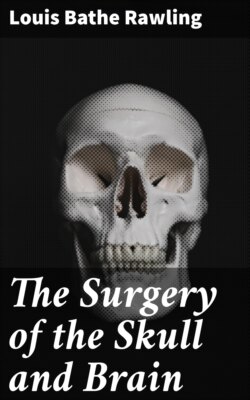Читать книгу The Surgery of the Skull and Brain - Louis Bathe Rawling - Страница 49
На сайте Литреса книга снята с продажи.
Position of the tumour.
ОглавлениеThe tumour may project through the vault or base of the skull. In the former case, it is almost invariably situated in close relation to the middle line of the skull, from nasion to below the inion.
Fig. 20. An Occipital Cephalocele. (For further description, see text.)
1. Occipital cephaloceles—the commonest variety—occupy, anatomically, two positions (1) between the two lower segments of the occipital bone (inferior occipital cephaloceles), often involving the foramen magnum and sometimes complicated by a condition of cervical spina bifida, and (2) between the two upper segments of the occipital bone (superior occipital cephaloceles), occasionally involving the posterior fontanelle.
The tumour may possess a broad base or may be definitely pedunculated. In the former instance the gap in the bone may be of considerable size and the margins everted: in the latter case, the hole may be quite small.
The deformity is frequently associated with other congenital defects—hydrocephalus, microcephalus, spina bifida, hare lip, hernia, and talipes.
2. Sincipital cephaloceles occur next in order of frequency. The tumour projects between the nasal bones and the nasal process of the superior maxilla (naso-frontal), between the nasal process of the maxilla and the orbital plates of the ethmoid (naso-ethmoidal), or between the nasal bones (nasal).
Fig. 21. A Cephalocele over the Anterior Fontanelle.
(For further description, see text.)
3. More rarely, the tumour overlies the anterior or posterior fontanelle. A case of this nature is depicted in Fig. 21, the tumour, situated over the anterior fontanelle, bulging over the temporal and frontal regions to a remarkable extent.
4. Basal cephaloceles protrude through the cartilaginous base of the skull, either through the cribriform plate of the ethmoid, between the pre- and basi-sphenoid, or between the basi-sphenoid and basi-occiput, often projecting as a polypoid growth in the nose or naso-pharynx.
An interesting case of basal hernia was reported by von Mayer.[8] The child, 3 days old, was admitted with a tumour projecting into the right nostril, covered with mucous membrane, translucent, encrusted with scabs, pedunculated, and closely resembling a nasal polypus. The possibilities were fully recognized and all necessary precautions taken. The right half of the nose was turned back as a flap, the tumour isolated, ligatured, and removed. Death occurred after six weeks. An oval hole was found in the left half of the cribriform plate through which the dura mater projected and to the margins of which the membrane was firmly adherent. The pedicle contained ganglion-cells and nerve-fibres, whilst the parts removed showed, from without inwards, mucous membrane, dura mater, arachnoid, pia, and glial tissue.
